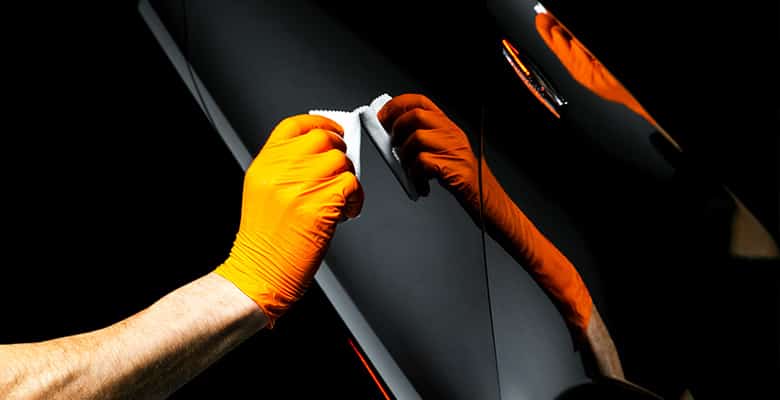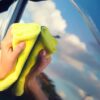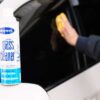What Is The Difference Between Ceramic Wax and Traditional Wax

Car enthusiasts covet that “wet look” candy gloss shine. It doesn’t matter whether you’re driving a family sedan or a vintage sixties-era muscle car. You want a terrific, long-lasting shine that makes you proud to head out on the open road.
From Carnauba Wax to Silicon Dioxide
Both traditional wax and ceramic wax deliver an attractive shine. Both products seal out water, guard against superficial scratches and resist contaminants. They are very different formulations, however.
Traditional wax has been around for more than a century. No sooner did the “horseless carriage” appear than owners started looking for ways to protect the paint. In 1910, George Simons came up with the idea of using carnauba wax in paste form to protect a car’s finish. It came from Brazil’s Carnauba Palm, known as “The Tree of Life.” It is one of the hardest natural waxes. The melting point is 185 degrees F.
Silicon dioxide (SiO2) in ceramic wax is very different. Compared to traditional wax, the melting point and hardness are off the charts. In crystalline form, silicon dioxide’s melting point is 3,110 degrees F. It rates a seven on the Moh hardness scale, the same as quartz.
Comparing Ceramic Wax and Traditional Wax
What are the differences between ceramic wax and traditional wax? First, they contain different things. Second, they differ in how long they last. Third, application methods vary. Two big advantages of SiO2 ceramic wax involve ease of use and frequency of use.
Different Formulations
A post at Jay Leno’s Garage discusses the many differences between a wax and a sealant. The composition of the two is quite different. Traditional wax often includes Carnauba wax. It is somewhat brittle in pure form. As a result, formulations often include beeswax, natural oils and/or petroleum distillates. Its lower melting point may attract dust to the surface.
Ceramic wax is more of a sealant. There are SiO2 nanoparticles suspended in a polymer resin. The microscopic nature of the particles makes it easier for them to penetrate the surface of a car’s finish. The result is a hard, glass-like surface that is very durable.
Resisting Contaminants and Elements
It’s too bad our vehicles can’t tell us more. Imagine a talking car that could complain when its skin is under assault. Think about Kitt, that black Pontiac Trans-Am in the 1980s series Knight Rider, for example. You’d hear about how it prefers not to bake in the hot sun or take on razor-sharp sand particles at freeway speeds. You’d hear about those acidic compounds that eat away at its surface.
There are more contaminants assaulting your vehicle’s finish than you might think. There’s the road salt in the winter and the potential for acid rain in the summer. There are corrosive compounds like tree sap, bug residue, and brake dust.
Extreme heat, ultraviolet light, and detergents also take a toll. This is true whether you have single-stage paint on a classic or clearcoat on a more current model. In many situations, ceramic wax is better than traditional wax. It better resists the many things that assault your vehicle’s exterior finishes.
Hydrophobic Effect
What do you think when you see the term “hydrophobic?” Some might think it has something to do with a fear of water, and that’s close. It actually refers to repelling water. When it comes to automotive protectants, the more hydrophobic the formula, the better.
Car detailers sometimes refer to it as the “lotus effect.” In nature, the leaves of aquatic lotus plants (nelumbo nucifera) are amazingly hydrophobic. So much so that the leaves are self-cleaning.
Ceramic wax is extremely hydrophobic. Water beads up as it glides off of vehicle finishes. It takes dirt, salt, and other contaminants along with it. At highway speeds, watch as torrents of rain bead up and glide off treated glass as well.
Time Invested
When you save time on car care, there are more opportunities for fun in the sun. Ceramic wax lasts for months. By contrast, traditional carnauba waxes last about 3-5 weeks. Eliminate repeated waxings throughout the year, and you’ll save hours and hours.
Temperature During Application
The application of ceramic wax and traditional wax is similar in one way. You want to make sure your vehicle’s been out of the sun for several hours.
Ambient temperatures are more of an issue with traditional wax. It’s best to apply paste wax when outdoor temperatures are between 60 and 80 degrees. At lower temperatures, these waxes don’t liquefy enough during application. During a cold, snowy winter, squeezing in a monthly waxing is tricky, to say the least.
Ceramic wax is not as temperature critical. It’s also easier to deal with the arrival of snow and cold. Apply a ceramic wax late in the fall to get months of protection.
Ease of Application
Ceramic wax and traditional wax are similar in one way – apply either to a clean surface. Traditional wax requires a dry surface, while ceramic wax does not. Spray ceramic wax on a clean surface and wipe with a microfiber towel to reveal a high gloss finish. Natural carnauba paste wax also requires time to dry. You have to wait before you buff the residue away.
Freedom of Application
SiO2 ceramic wax is hard and crystal clear. It’s safe to use on all exterior surfaces, including clearcoat, paint, glass fiberglass, plastic, and metal. When you use traditional wax, you have to take care to keep it off of certain adjacent surfaces. It’s not wise to get traditional wax on your windshield, for example. When you use a SiO2 ceramic sealant, you don’t have to worry.
Ceramic Wax vs Traditional Wax: Final Thoughts
For decades, waxing the car was an American tradition. Car owners applied traditional wax every month or so. They’d spend hours rubbing it on, letting it dry and wiping the residue away.
Today, there’s an alternative. SiO2 ceramic wax is a high-tech product offering “spray-on, wipe off” simplicity. The glass-like surface delivers protection lasting for months. It resists UV light and airborne particles. It also resists waterborne contaminants like road salt.
About Sprayway Automotive
Auto detailing professionals have used Sprayway’s products since 1947. Sprayway’s interior and exterior car care products are American-made and world-class.
Sprayway SiO2 Ceramic Wax delivers advanced protection to all hard exterior surfaces. Apply it to paint, clear coat, chrome, plastic, and even glass. Use it on your vehicles, RV, motorcycle, ATV and more. The super-hydrophobic formula delivers the superior water beading car enthusiasts love.
Recent Post

Water-based Cleaners vs Solvent-based...

The Different Kinds of Tinted Windows...
